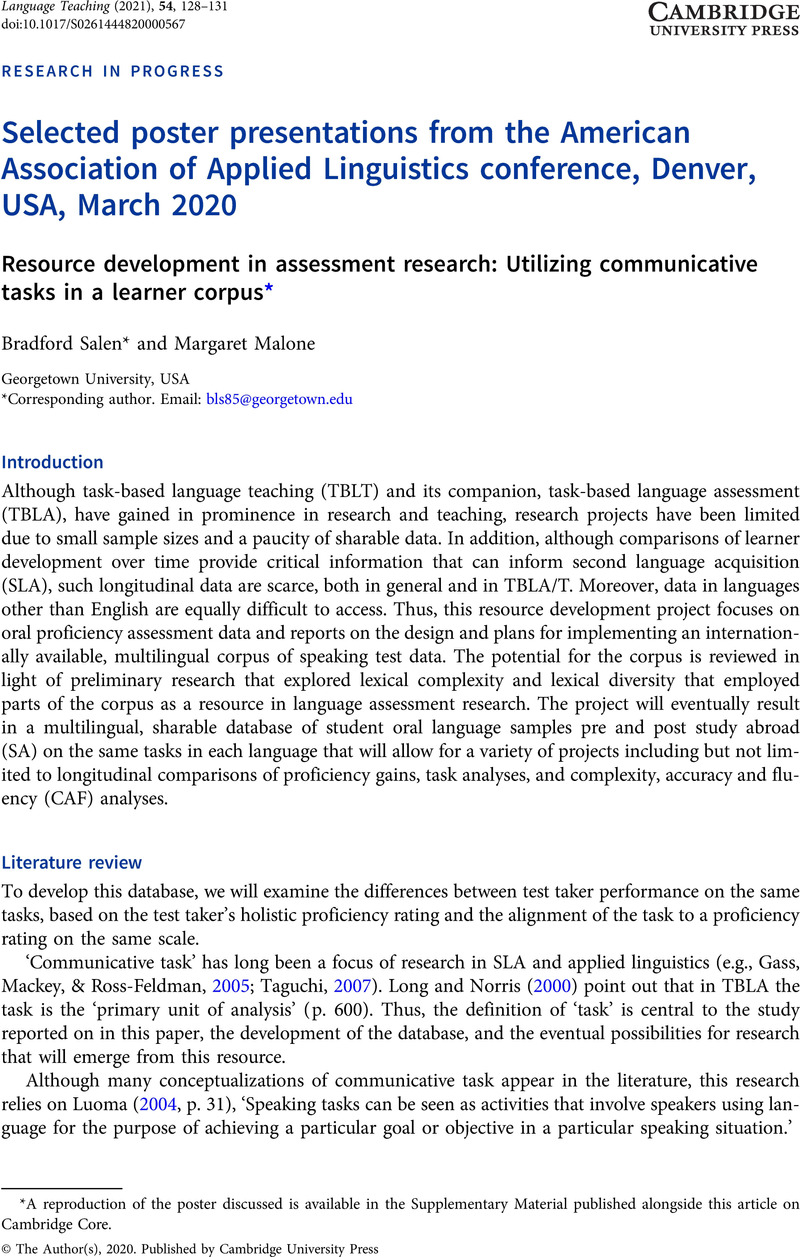No CrossRef data available.
Article contents
Selected poster presentations from the American Association of Applied Linguistics conference, Denver, USA, March 2020
Resource development in assessment research: Utilizing communicative tasks in a learner corpus
Published online by Cambridge University Press: 16 November 2020
Abstract
An abstract is not available for this content so a preview has been provided. Please use the Get access link above for information on how to access this content.

- Type
- Research in Progress
- Information
- Copyright
- Copyright © The Author(s), 2020. Published by Cambridge University Press
Footnotes
A reproduction of the poster discussed is available in the Supplementary Material published alongside this article on Cambridge Core.
References
Amoroso, L. W. (2015). I don't know what it is, but I know it when I hear it: Speaking proficiency and the ACTFL OPI (Doctoral dissertation). Georgetown University, USA.Google Scholar
Bird, S., Klein, E., & Loper, E. (2009). Natural language processing with Python: Analyzing text with the natural language toolkit. Sebastopol, CA: O'Reilly Media, Inc.Google Scholar
Davies, Mark. (2008-) The Corpus of Contemporary American English (COCA): 600 million words, 1990–present. Retrieved from https://english-corpora.org/coca/Google Scholar
De Jong, N. H., & Wempe, T. (2008). Praat script to detect syllable nuclei and measure speech rate automatically. Behavior Research Methods, 41(2), 385–390.CrossRefGoogle Scholar
Gass, S., Mackey, A., & Ross-Feldman, L. (2005). Task-based interactions in classroom and laboratory settings. Language Learning, 55(4), 575–611.CrossRefGoogle Scholar
Jarvis, S. (2013). Capturing the diversity in lexical diversity. Language Learning, 63, 87–106.CrossRefGoogle Scholar
Long, M. H., & Norris, J. M. (2000). Task-based teaching and assessment. In Byram, M. (Ed.), Encyclopedia of language teaching (pp. 597–603). London: Routledge.Google Scholar
Luoma, S. (2004). Assessing speaking. Cambridge, UK: Cambridge University Press.CrossRefGoogle Scholar
Malone, M. (2000). Simulated oral proficiency interviews: Recent developments. Center for Applied Linguistics, Washington, DC: ERIC Digest.Google Scholar
Myers, R. (2020). The effects of proficiency level and task level on linguistic production: A CAF analysis of Spanish SOPI data. (Unpublished M.S. thesis) Georgetown University, USA.Google Scholar
Norris, J., & Ortega, L. (2009). Towards an organic approach to investigating CAF in instructed SLA: The case of complexity. Applied Linguistics, 30(4), 555–578.CrossRefGoogle Scholar
Taguchi, N. (2007). Task difficulty in oral speech act production. Applied Linguistics, 28(1), 113–135.CrossRefGoogle Scholar
Vande Berg, M., Connor-Linton, J., & Paige, R. M. (2009). The Georgetown consortium project: Interventions for student learning abroad. Frontiers: The Interdisciplinary Journal of Study Abroad, 18, 1–75.CrossRefGoogle Scholar
Yu, G. (2010). Lexical diversity in writing and speaking task performances. Applied Linguistics, 31(2), 236–259.CrossRefGoogle Scholar



